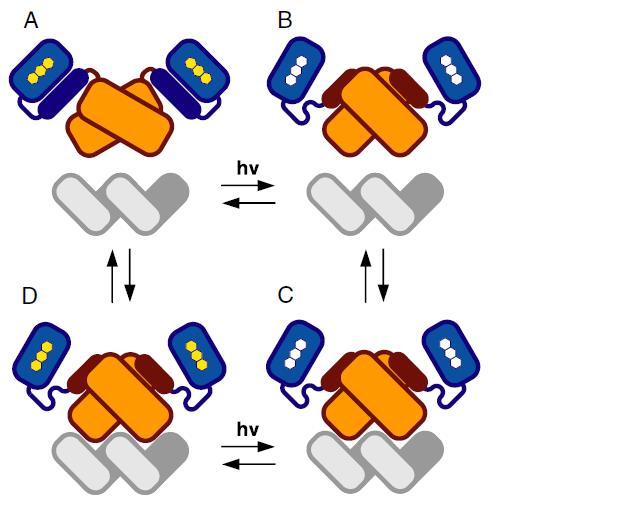Team:EPF-Lausanne/LOVTAP
From 2009.igem.org
(→Genetic circuits) |
(→Genetic circuits) |
||
| Line 43: | Line 43: | ||
==Genetic circuits== | ==Genetic circuits== | ||
| - | Readout 1 : | + | '''''Readout 1 :''''' |
<br>[[Image: RO1.jpg|RO1]] | <br>[[Image: RO1.jpg|RO1]] | ||
Revision as of 14:01, 7 September 2009
Brief overview
In the article of Strickland et al., an allosteric switch was created by joining two domains. The resulting protein has a domain-domain overlap with a shared helix. This shared helix acts as a rigid lever arm. The disruption of the helical contacts causes a shift in the conformation. Thus, photoexcitation would change the conformation of the protein, and that will change the stability of the helix-domain contacts. This will change the affinity of the shared helix for the two domains, and a signal could be then sent.
For organisms to thrive in a changing light environment, they sense and respond to light: The sensory information allows them to move. These responses are mediated by phototropins, photosensory proteins consisting of a serine- threonine kinase domain and a pair of nonidentical Light, Oxygen, or Voltage (LOV) sensitive domains which contain the noncovalently bound chromophore flavin mononucleotide (FMN).
In the LOVTAP system, the light-sensitive input module is the LOV2 domain of Avena sativa phototropin 1 (AsLOV2). Absorption of a photon by AsLOV2 triggers the formation of a covalent adduct between FMN (the flavin mononucleotide) cofactor and a conserved cysteine residue. This formation leads to the displacement and unfolding of an helix in the LOV domain, which is likely to mediate a signal propagation.
The output module was the bacterial transcription factor trp repressor (TrpR). TrpR can bind its operator DNA as a homodimer.
By ligating AsLOV2 to TrpR, they were able to construct an allosteric switch called LovTAP : LOV- and tryptophan-activated protein. This protein protects DNA from digestion when illuminated.
LovTAP can thus be found in two states : dark-state and light-state. The ground state is referred to as the ‘‘dark’’ state, and its photoactivated state as the ‘‘light’’ state. The TrpR domain associates with the shared helix (shared from AsLOV2 and TrpR).
- In the dark state (A in the image below), a few residues of the shared helix presumably dissociate from the TrpR domain and dock against the LOV domain. The steric overlap is then relieved, which decreases the TrpR domain's DNA-binding affinity (when the shared helix contacts the LOV domain, the TrpR domain is in an inactive conformation).
- In the light state, the residues reassociate with the TrpR domains (because the photoexcitation disrupts contacts between the shared helix and the LOV domain), which restores DNA-binding affinity and the system is in the active form (B). LovTAP can then bind DNA. But this system is not stable, and the LOV domains returns to the dark state (C), which triggers the dissociation of LovTAP from the DNA (D).
In our project, the idea is to implement such a system in E. coli, using synthetic biology and then caracterise it in vivo (in the article they have only done the caracterisation in vitro).
First of all, we want to clone the LovTAP gene into an IPTG inductible BioBrick using a LacI promoter from the registry as well as a RBS and a terminator. Following this, we will clone a readout that would express RFP upon ligation of the LovTAP (after illumination) to its promoter sequence (the trp promoter). As we want to have RFP expression upon illumination (and thus binding of the LovTAP), we will need to create an inverter.
Genetic circuits
To get
in vitro
- Sequence of the 12 mutant fusion proteins or LOV domain AND TrpR (separately) => [http://www.ncbi.nlm.nih.gov/ Pubmed]
- Purification kit&Digestion assay protocol => find the purification protocols etc. in the supplementary material
- LED/light sources or photometer -> Heidi is ordering them
- Calmodulin kit or stuff for protection assay
in vivo
- Inducible promoter: IPTG
- Reporter cassette: RFP
To do: theory
in vivo
- - Find the exact genetic circuit for Trp repressor
An interesting course on TrpR and Trp operon: [http://www2.hawaii.edu/~scallaha/SMCsite/475%20Lectures/475Lecture34.pdf TrpR]
- - Biobricks
Look for a (or many) paper(s) that characterizes E.Coli Trp repressor, and find the Trp operon sequence :
Summary of what characterizes E.Coli Trp repressor : The tryptophan biosynthetic pathway
One good article : RNA-based regulation of genes of tryptophan synthesis and degradation
Protein sequence from NCBI here
Design a biobrick that coexpresses LOVTAP and RFP (after Trp operon) when LOVTAP binds the Trp operon. Design a switch on/off read out.
To do: wet lab
in vitro
- - Redo the experiment they did in the LOVTAP article (2)
Major problem, the conformational change of LOVTAP is weak and the protection assay results show a small difference of LOVTAP binding on DNA between dark state and light state !!! ----> try to improve this
- Express and purify mutants
- is flavin indispensable ?
- Trp has to be added
- - Do a mutational assay to change or enhance specificity of LOVTAP
- Directed mutational assay: Insert mutation in specific sites thanks to the known structure of LOVTAP (already modeled on computer)
- Indirect mutational assay: Random mutations, then selection of the "right" protein according to a set of selected conditions
- In vivo: Evolved mutational assay: LovTap inhibit a killer gene, so the more the LovTAP affinity for DNA is high the more likely cells will survive (simulation of evolutionary selection)
- Other in vitro techniques: SELEX
in vivo
- Express LOVTAP under control of an inducible promoter
- Link a reporter cassette with TrpR binding domain
 "
"





